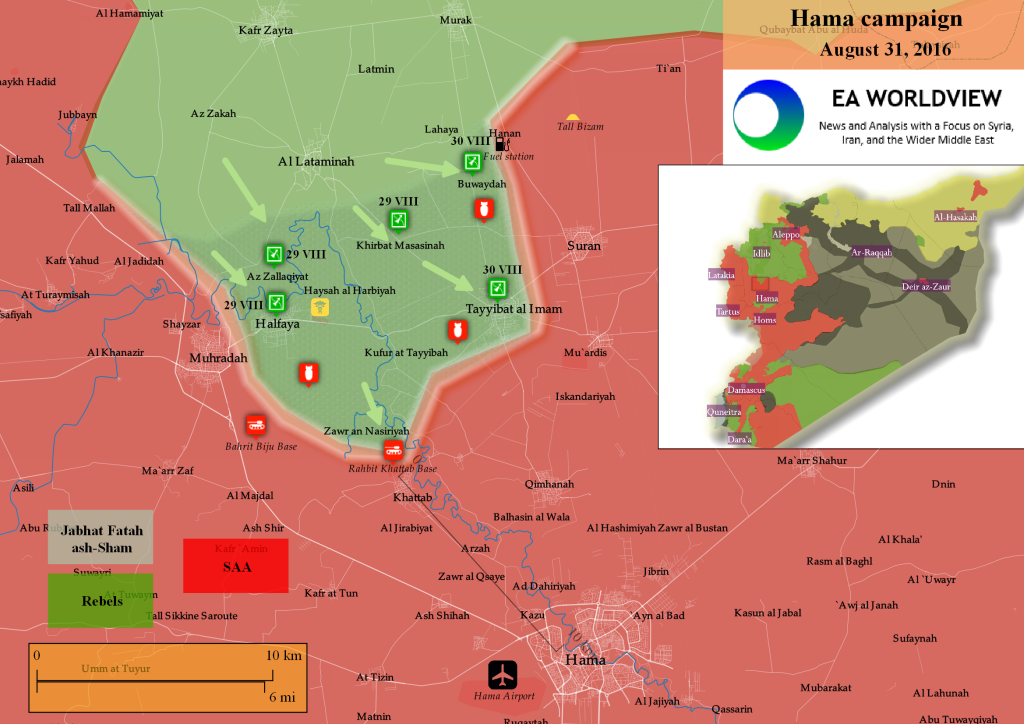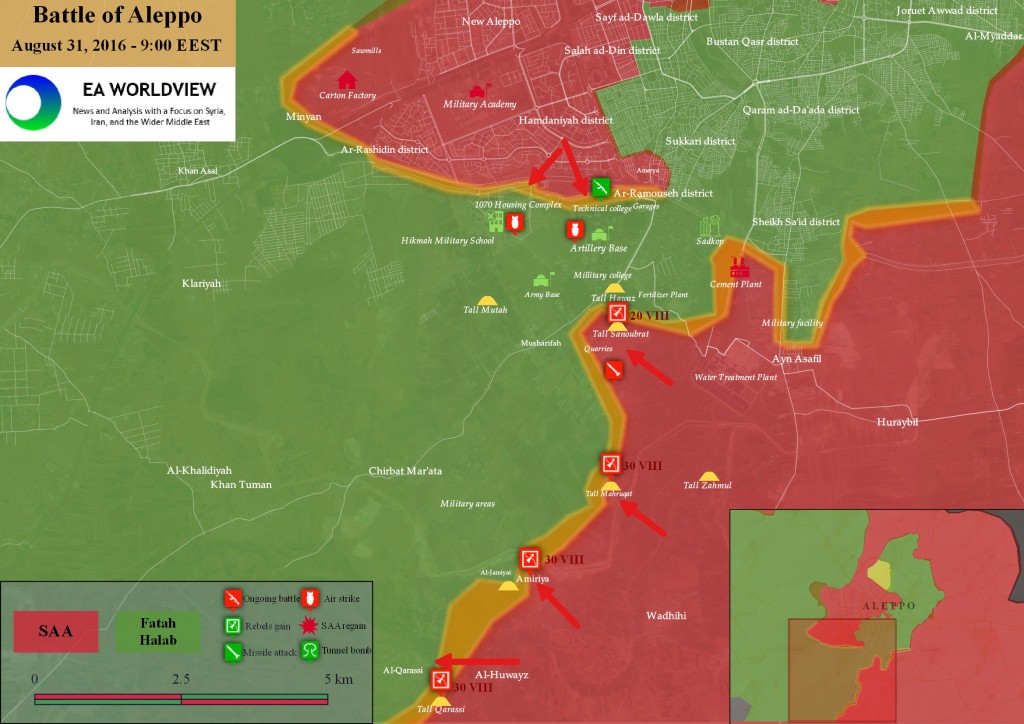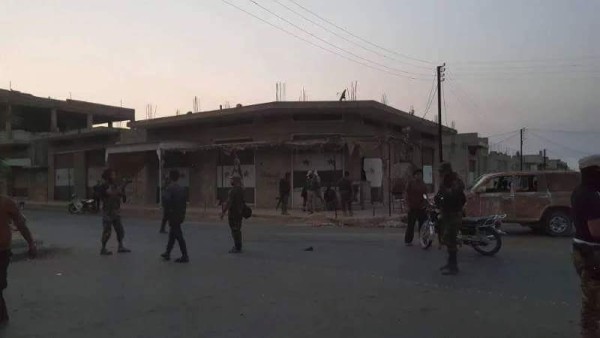PHOTO: Rebels in the town of Taibat al-Imam on Tuesday
LATEST
- Opposition Provisionally Accepts Truce in Besieged al-Wa’er in Homs
- ISIS Spokesman Al-Adnani Killed in Aleppo Province
- Russia Blocks UN Action on Assad Regime’s Chemical Attacks
- US Claims Truce in Rebel Fighting with Kurdish-Led SDF; Turkey and Rebels Say No
UPDATE 1510 GMT: Rebels have captured the town of Souran.
There was some confusion over the initial claims, but a regime counter-attack has been repelled and the town is under rebel control.
Hama: footage of rebels after capture of Souran pic.twitter.com/XEmvVTr7MI
— Malcolmite (@Malcolmite) August 31, 2016
Speculation is now rising that rebels will take on the challenge of the heavily-fortified village of Ma’an, northeast of Souran (see map). Activists say seven position to the west and north have already been taken.
Ma'an village has underground depots, fortifications, earth barriers, and trenches. No vehicles can pass through except from the South.
— أبو خالد الشام (@ahlalsham3) August 31, 2016
More checkpoints have been taken, with tanks and other armored vehicles captured.
N. #Hama (updated map): Rebels seized over 75 km² & in 3 days & more than 20 militiary positions. Offensive widening pic.twitter.com/E10z1bGtte
— Qalaat Al Mudiq (@QalaatAlMudiq) August 31, 2016

UPDATE 0945 GMT: In northern Hama Province, rebels have advanced towards the town of Souran, taking a nearby checkpoint. They reportedly captured three tanks and ammunition.
UPDATE 0845 GMT: On the front west of Aleppo city, rebels say they have regained the Jamiyat hill after it was briefly taken by pro-Assad forces last night.
The rebels also said they had reclaimed more than 15 of the buildings occupied by the pro-Assad forces in the 1070 housing complex, near the large artillery base captured in a rebel offensive early this month.
The pro-Assad forces — mainly Iraqis and Hezbollah, according to a local source — still hold the hill of Mahruqat and the village of Amiriyah after their attacks on Tuesday.
Map from a pro-opposition activist:

ORIGINAL ENTRY: Syria’s rebels advanced farther in northern Hama Province on the second day of their offensive on Tuesday.
Having taken three villages and the town of Halfaya on Monday, the rebels moved into more villages and the town of Taibat al-Imam yesterday to close within 10 km (6 miles) of Hama city.
The rebels regained al-Buwaydah, which they had briefly held on Monday before withdrawing under airstrikes. They then secured Taibat al-Imam.
By last evening, they were in the village of Khattab, with a significant arms depot, northwest of Hama. They later withdrew just outside the village to avoid being surrounded by any counter-attak.
Local observers still believe an advance on Hama city is unlikely. Rebels may be considering a move to the west on Mahardeh. However, the town presents military and political challenge, as both a “reservoir” of manpower for pro-Assad forces and a significant Christian population.

The offensive is linked to the rebel gains since late July on the front southwest of Aleppo, Syria’s largest city, which has broken a pro-Assad siege and taken a large artillery base. It is likely to force already-overstretched Syrian forces to choose between bolstering Hama or continuing the attempt to regain territory in southwest Aleppo, possibly moving forces from Latakia Province to the west and checking efforts to advance there.
On Tuesday, the regime and its foreign allies, including Iran and Hezbollah, appeared to be concentrating on the Aleppo front.
Yet another attempt to re-enter the artillery base and air force college, taken by rebels in early July, failed although pro-Assad forces reportedly did take the hill of Sanoubrat.
However, pro-regime outlets claimed success in an offensive to the west of Aleppo city, claiming an advance towards Khan Tuman, the town on the Aleppo-to-Damascus highway taken by rebels in early April.
Rebels disputed the claims, saying that they had regained the village of Qarassi after a 15-hour battle. They did acknowledge that the pro-Assad forces had taken the village of Amariyah and two hills, Mahruqat and Jamiyat.
One well-placed source said the attackers were “almost all Iraqis or Hezbollah”.
Iranian units, Iranian-led foreign militias, and Hezbollah have done much of the fighting on the southwest Aleppo front since last autumn because of the depleted Syrian military.

Opposition Provisionally Accepts Truce in Besieged al-Wa’er in Homs
Opposition authorities in the besieged al-Wa’er district of Homs city provisionally agreed on Wednesday to a regime truce proposal.
The initiative calls for the eventual evacuation of all rebel fighters from al-Wa’er, which is home to about 80,000 people. Tabled on Monday, it also provides for an extended ceasefire, the entrance of food and medicine into the district, the release of regime detainees, and the eventual return of police and State institutions.
Opposition negotiators accepted with two conditions: 1) UN-approved monitors oversee implementation and 2) the regime announces the exact number of detainees to be released.
Regime representatives said they will respond within 48 hours.
Two rebel negotiators told Syria Direct that the committee was split over acceptance of the proposal.
“At the end of the day, we are against the renewed shelling and killing of Wa’er residents and we are against the total evacuation of the district. To us, both options mean death,” Abu Zuheir said.
A second negotiator said, “Every time [we enter into an agreement], the regime goes back on its promises and returns to bombing the district in order to extract more concessions.”
Al-Wa’er, the last opposition-held district in Homs, has been besieged since 2013. An initial truce was reached in December 2015, but implementation stalled over the terms of the evacuation of fighters. The regime has continued the siege and bombardment, returning to airstrikes last week, to try and force a capitulation.
ISIS Spokesman Al-Adnani Killed in Aleppo Province
The Islamic State has announced the death of its spokesman Abu Muhammad al-Adnani in Aleppo Province.
Pentagon spokesman Peter Cook confirmed that a US airstrike near al-Bab on Tuesday night targeted Adnani, but could not confirm his death.
However, two US officials said a military drone had hit a vehicle in which Adnani was thought to be traveling.
The Islamic State has fallen back on al-Bab following the loss of its major position in Aleppo Province, the city of Manbij, to the the Kurdish-led Syrian Democratic Forces last month. ISIS has lost further territory in northern Syria in the last week to a Turkish-backed rebel offensive.
Adnani, a 39-year-old Syrian, was a founding member of the Islamic State and put out almost all of its statements.
Russia Blocks UN Action on Assad Regime’s Chemical Attacks
Russia indicated on Tuesday that it will block any Security Council action over a UN report which, for the first time, found the Assad regime responsible for chemical attacks.
Last week’s report by the UN and the Organization for the Prohibition of Chemical Weapons tied the regime to chlorine assaults on two towns in Idlib Province in spring 2015. Previous UN investigations — including of the sarin attacks near Damascus in August 2013 that killed at least 1,400 people — have not been able to assign responsibility because of Security Council restrictions
Russia’s Ambassador to the UN, Vitaly Churkin, acknowledged after a closed-door Council meeting on Tuesday that chlorine is being used, despite the Assad regime’s supposed handover of chemical weapons and destruction of facilities.
However, he ruled out any action with Russia’s line that there was no proof of the Syrian military’s responsibility:
Clearly there is a smoking gun. We know that chlorine most likely has been used — that was already the finding of the fact finding mission before – but there are no fingerprints on the gun.
There is nobody to sanction in the report which has been issued. It contains no names, it contains no specifics….If we are to be professional we need to question all the conclusions.
In his presentation to the Council, the diplomat went farther, effectively accusing the UN of complicity or naïveté in the fabrication of evidence:
Already at this stage, we have a number of questions regarding the findings of the OPCW-UN Joint Investigative Mechanism on some cases. Evidence provided in the report gives rise to serious doubts. It could have been fabricated by the forces opposed to Damascus and terrorist groups, perhaps not without outside help.
And the ambassador tried to construct a scenario in which Syrian rebels could have dropped the chlorine canisters. Russian State outlet RT summarized:
Churkin noted that report also stated that rebels managed to capture an airfield which had nine combat-ready helicopters, which could have been used by rebels who have necessary technical skills and training to operate the machines.
Syrian Ambassador Bashar al-Ja’afari — who last week blamed the attacks near Damascus in 2013 on France — insisted that the UN investigators had been misled:
The conclusions contained in the report were totally based on statements made by witnesses presented by the terrorist armed groups. Therefore, these conclusions lack any physical evidence.
The Assad regime has used chlorine in attacks across northwest Syria since 2014, killing scores of civilians and injuring hundreds.
US Claims Truce in Rebel Fighting with Kurdish-Led SDF; Turkey and Rebels Say No
The US and a Kurdish official claimed on Tuesday that fighting had stopped between Turkish-backed rebels and the Kurdish-led Syrian Democratic Forces in northern Syria, but Turkey rejected the assertion.
White House spokesman Josh Earnest said, “The United States welcomes the overnight calm between the Turkish military and other counter-ISIL [Islamic State] forces in Syria,” while the State Department’s John Kirby said the period of calm had lasted 12 to 18 hours and the US would like it to continue.
A Kurdish military official also said a ceasefire between Turkey and the SDF was holding.
However, Turkey said there was no truce and summoned US Ambassador John Bass to express “disturbance” over Washington’s remarks.
“It has been underlined that such statements are by no means acceptable and that they do not comply with the alliance relationship,” the Foreign Ministry said in a statement.
Spokesperson Tanju Bilgiç added that operations will continue until all “terror groups” are pushed away from the Turkish border so that they will not be able to “pose a threat to Turkish citizens”.
He reiterated Turkey’s expectation that the US will keep its word to ensure the Kurdish militia YPG, which is the leading force in the SDF, withdrew to the east of the Euphrates River.
A rebel commander said there was only a “pause” with military operations soon resuming.
In its first significant military intervention in Syria’s 5 1-2 conflict, Turkey carried out aerial operations and sent in tanks and special forces alongside rebels who crossed the border into northern Aleppo Province last Wednesday.
After quickly taking the border town of Jarablus, the force has moved south to the Sajur River. It is closing on the city of Manbij, taken by the SDF from the Islamic State last month.
The rebels are also advancing west from Jarablus, taking a series of villages from ISIS on the way to the town of al-Rai.

Turkish Tank Hit, 3 Soldiers Wounded
The Turkish General Staff said a tank was struck on Tuesday by a rocket fired to the west of Jarablus, “slightly damaging” the vehicle and wounding a lieutenant colonel and two other troops.
The military said a “group of terrorists” who staged the attack were killed and their vehicles destroyed.
The statement did not identify the attackers, but the incident occurred in the area where the Turkish-supported rebel offensive is pushing back the Islamic State.
The Kurdish-led SDF struck a tank last week, killing one soldier and wounding three others.

